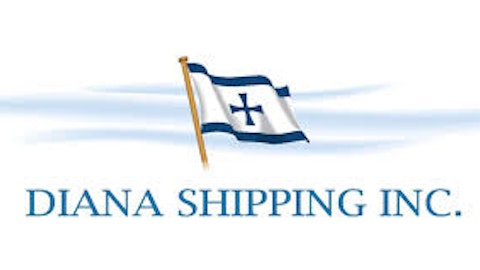The dry bulk shipping sector is, without a doubt, one of the most hated sectors in the market right now, and has been for quite some time. Anyone who invested in a dry bulk shipper before the great recession hit has gotten burned, or in the case of Star Bulk Carriers Corp. (NASDAQ:SBLK) absolutely incinerated. See for yourself.
While the drops weren’t nearly as gut-wrenching, Safe Bulkers, Inc. (NYSE:SB) and Diana Shipping Inc. (NYSE:DSX) have also been crushing disappointments for their shareholders.
Bearish arguments
One of the biggest arguments on the bear side of the dry bulk shipping debate is that an oversupply of ships will seriously dampen the ability of companies in the sector to generate profits.
According to Clarksons, total tonnage of the world’s dry bulk fleet has increased by 41.25% since 2008.
Yet, there are some signs that the glut may be coming to an end. Rongsheng Heavy Industries Group, China’s largest private shipyard, has seen its shares drop more than 20% in less than a week. Reports of the company conducting massive layoffs have recently surfaced. It posted a loss of nearly $100 million in 2012, after three straight years of profitability.
Another common reason the bears give for having disdain for dry bulk shippers is that charter rates for vessels have experienced an incredibly steep drop.
You can’t have an article about dry bulk shippers without talking about the Baltic Dry Index, or BDI. The index is representative of the cost level for the seaborne transportation of dry bulk goods (grains, iron, coal etc.) A higher index equals higher transportation costs, which means more profits for shippers.
The index peaked at an all time high of 11,793 in 2008. Since then it has completely tanked. It hit a 16-year low last year of 647, which equates to a decline of over 94%! But the index has been on the rise. The current level of 1,103 represents a 55% gain since the beginning of this year.
The bullish side of things
When I made my first few investments I did not know very much. But I had read Benjamin Grahams’s The Intelligent Investor. One takeaway I got from the book was that buying businesses below tangible book value can be a very good thing. And the dry bulk shipping sector is full of companies selling at huge discounts to tangible book value.
Thus, I made an investment in a dry bulk shipper. I’m sitting at a loss right now, but I’m betting that in this case patience will be a virtue and not an act of stupidity.
The following table contains some basic balance sheet data on these three shippers (as well as current market caps):
| DSX | SB | SBLK | |
| Market Cap: | $817.6 M | $385.7 M | $29.7 M |
| Working Capital: | $370.59 M | $44.06 M | $1.28 M |
| Shareholders Equity: | $1265.16 M | $438.12 M | $117.95 M |
| Price/Tangible Book Ratio: | .64 | .89 | .26 |
All three of these companies are trading at discounts to both shareholder’s equity and tangible book values.
Based on those numbers it looks like Star Bulk Carriers Corp. (NASDAQ:SBLK) is definitely the riskiest of the three, but it also has the greatest potential upside. Diana Shipping Inc. (NYSE:DSX) is probably the safest bet of the three, although gains in any of these companies are far from certain to be sure.
The fleets
Dry bulk ships are classified based on the amount of deadweight tonnage, or DWT, they are capable of carrying. The smallest (and most common) are handysize, which have a carrying capacity of roughly 15,000-35,000 DWT. The largest group of ships are of the capesize variety, built to handle cargo loads of over 80,000 DWT.
Diana Shipping Inc. (NYSE:DSX)’s fleet consists of 33 ships. The average age of the fleet is 6.4 years and the average carrying capacity is 3.7 million DWT.
The fleet of Safe Bulkers, Inc. (NYSE:SB) is 26 ships strong. With an average age of 5.1 years, it has one of the younger fleets in the industry. The combined average carrying capacity of the fleet is approximately 2.37 million DWT.
Not surprisingly Star Bulk Carriers Corp. (NASDAQ:SBLK) has the smallest fleet of the group, currently comprised of 13 ships with a combined average carrying capacity of 1.3 million DWT. With an average age of 10.7 years, Star Bulk Carriers Corp. (NASDAQ:SBLK) also has the oldest fleet of the bunch.
Note that the descriptions above don’t account for the fact that each company is planning to grow its fleet in the coming years.
Diana Shipping Inc. (NYSE:DSX) expects to have added five ships to its fleet by 2016. Safe Bulkers, Inc. (NYSE:SB) intends to grow its fleet by eight ships within two years. And Star Bulk Carriers Corp. (NASDAQ:SBLK) recently commenced a backstopped equity rights offering in which it plans to raise $75 million, primarily for the purpose of purchasing fuel-efficient dry bulk vessels.
Given how manufacturers of ships went way overboard in recent years, now seems like a smart time for shippers to expand their fleets.
Foolish bottom line
The dry bulk sector was one of the hardest hit by the great recession. Several of the weaker shippers have been forced to declare bankruptcy. But as survival of the fittest dictates, only the best will emerge from the wreckage.
Seeing as how the majority of dry bulk shippers are trading at a discount to book value, those that can manage to survive should deliver satisfying rewards to shareholders.
It appears the Baltic Dry Index has bottomed out. And while it isn’t exactly smooth sailing ahead for these companies, it appears the darkest days are behind them.
Investing in this sector isn’t for the faint of heart. But investors with high tolerance for risk might want to consider adding a dry bulk shipper to their portfolios. The ideal time to do so would be before Wall Street starts paying them any attention again.
The article Is It Time to Invest in the Dry Bulk Shippers? originally appeared on Fool.com.
Fool blogger Ryan Palmer owns shares of Star Bulk Carriers. The Motley Fool does not recommend or hold a position in any of the companies mentioned. Ryan is a member of The Motley Fool Blog Network — entries represent the personal opinion of the blogger and are not formally edited.
Copyright © 1995 – 2013 The Motley Fool, LLC. All rights reserved. The Motley Fool has a disclosure policy.





